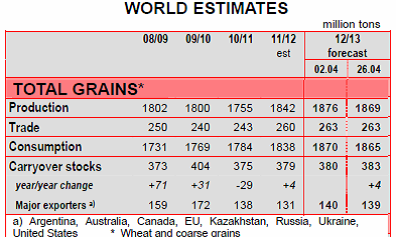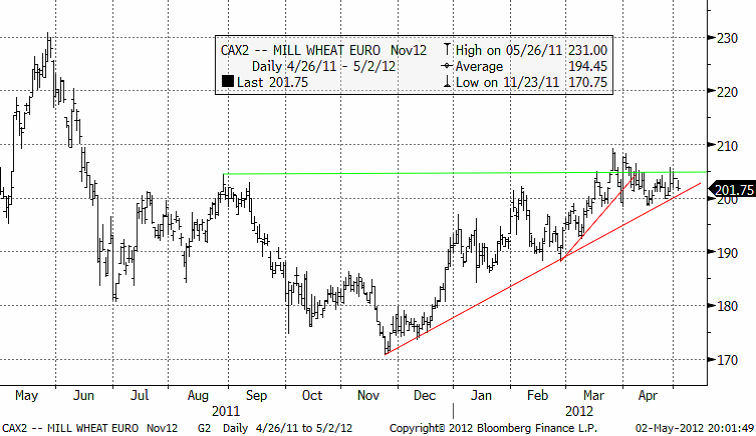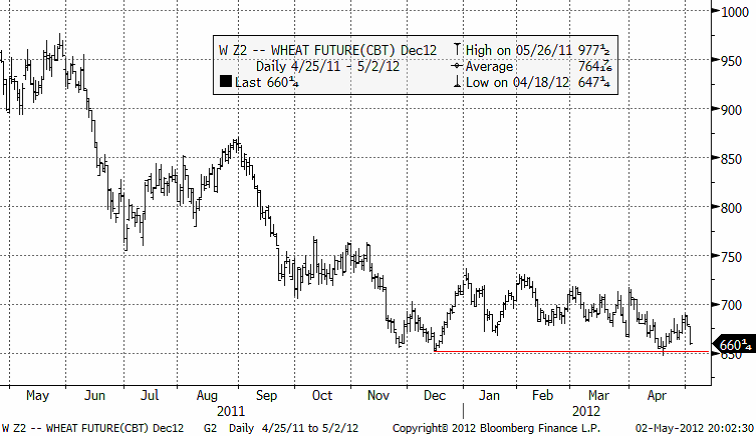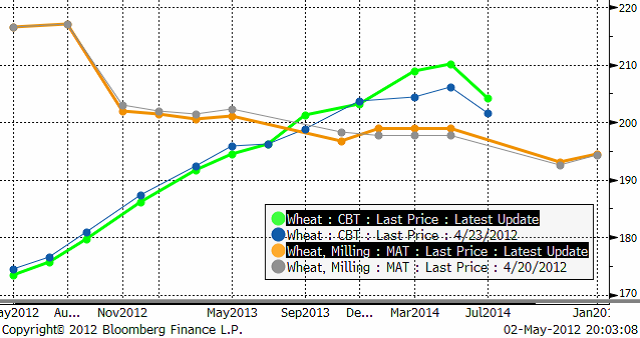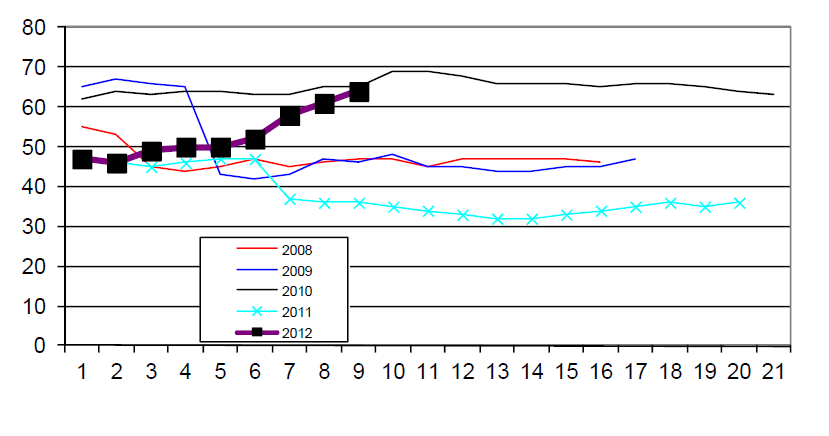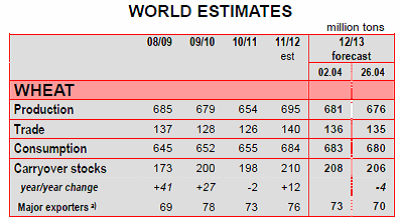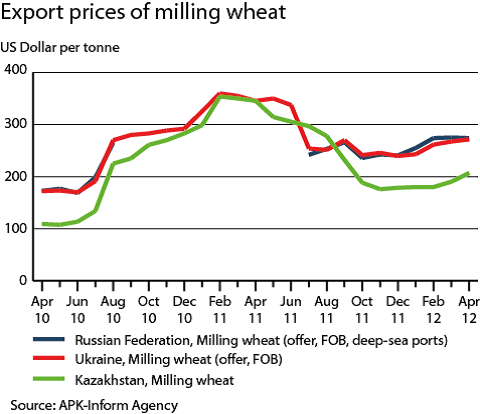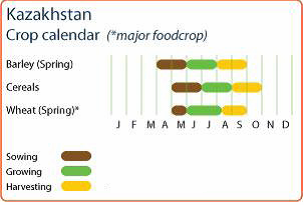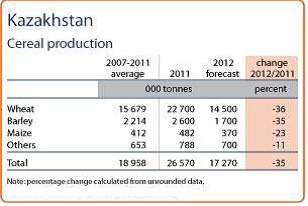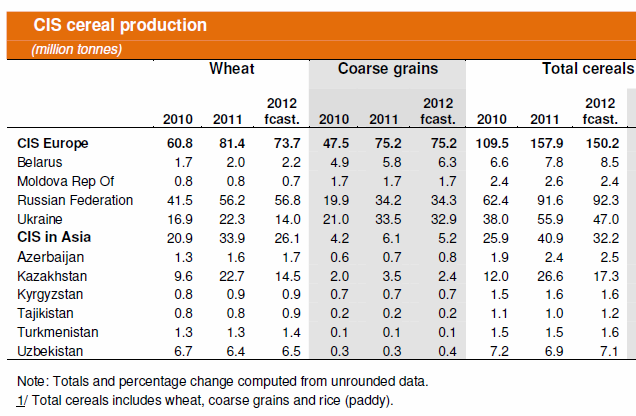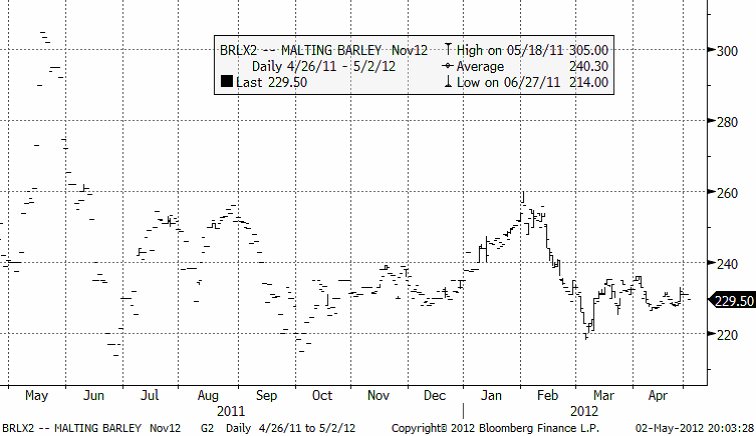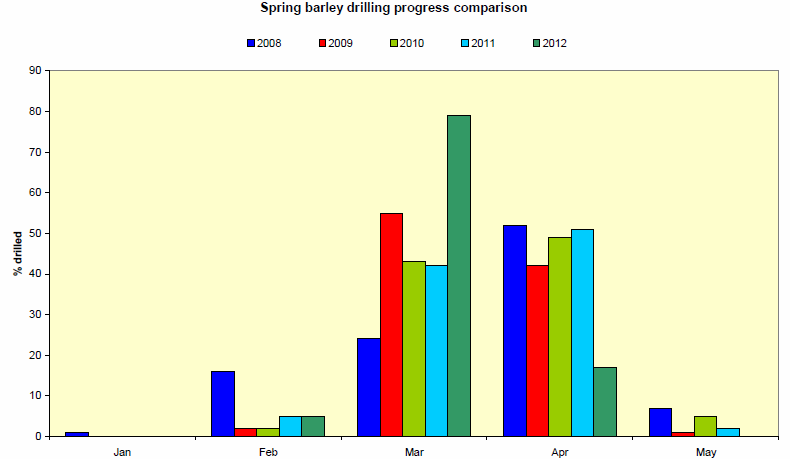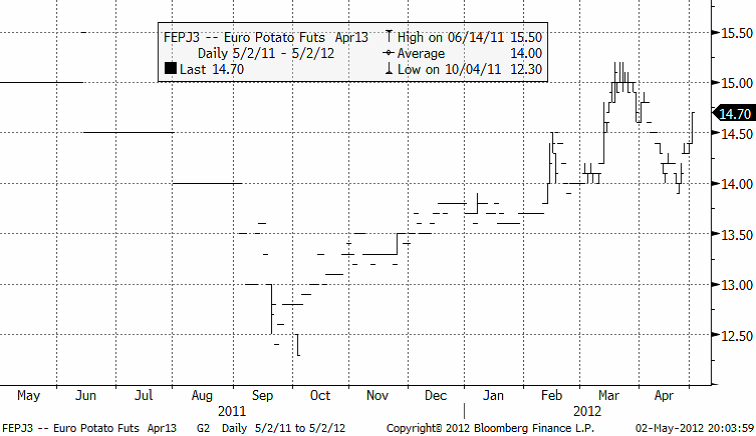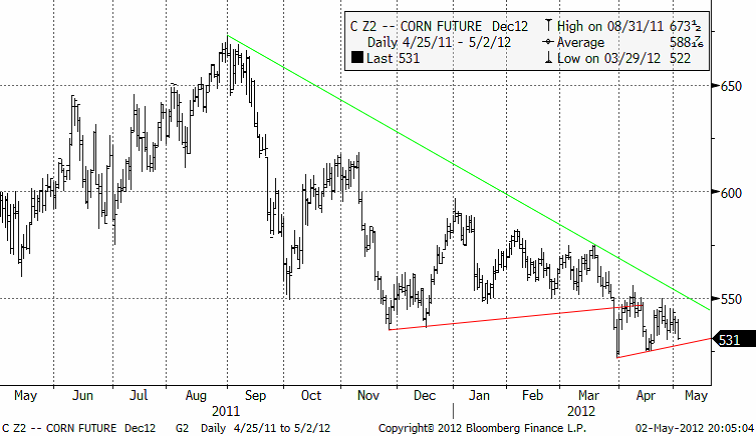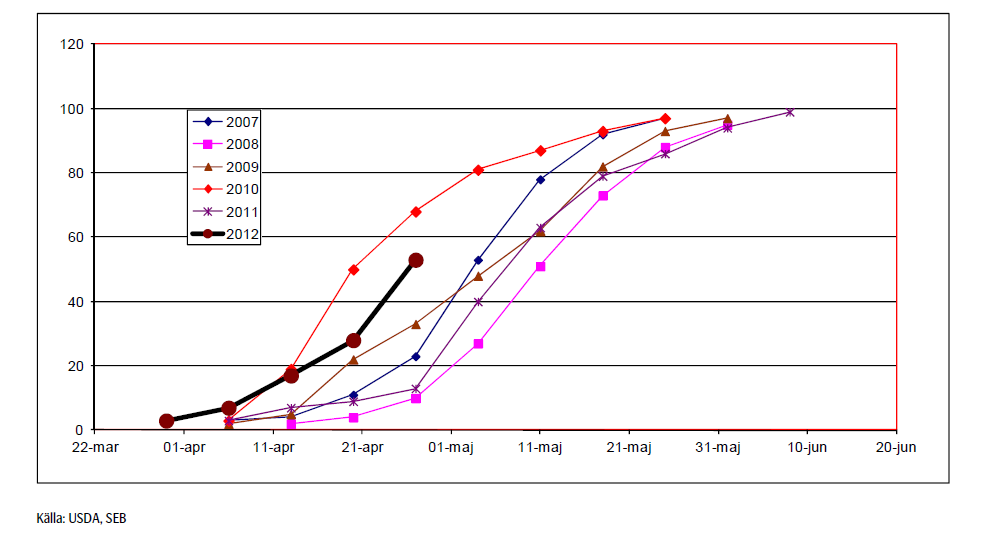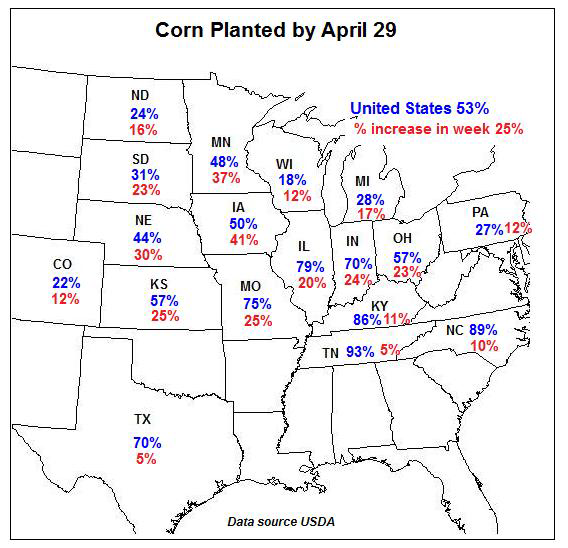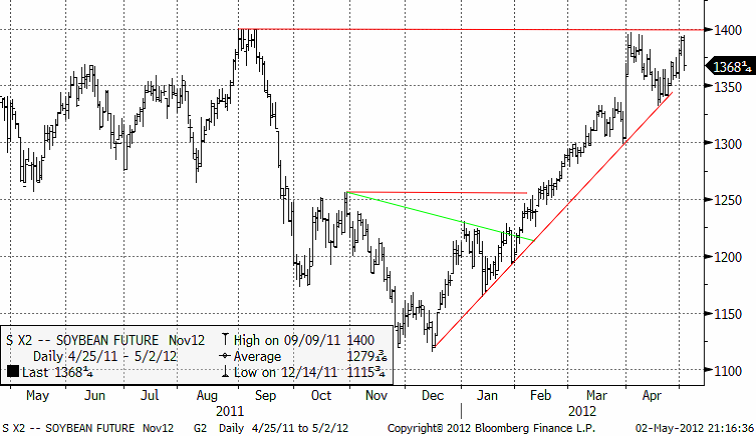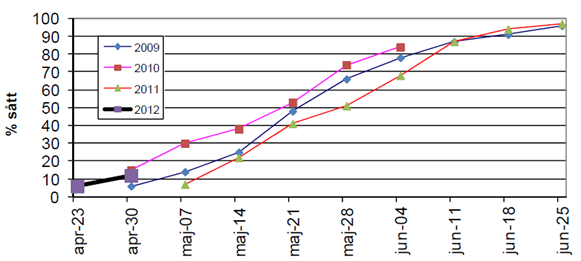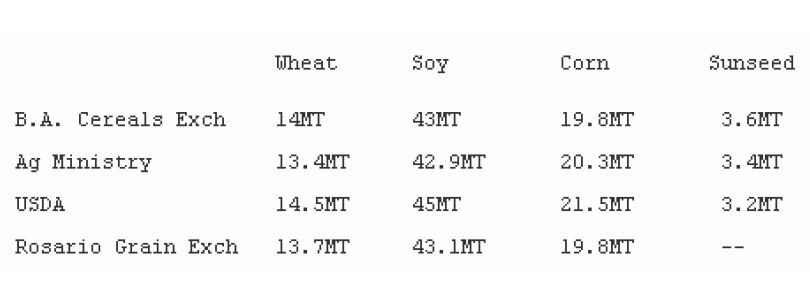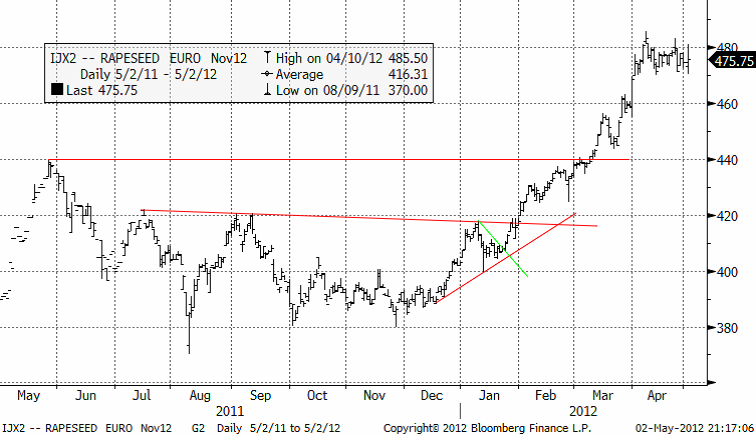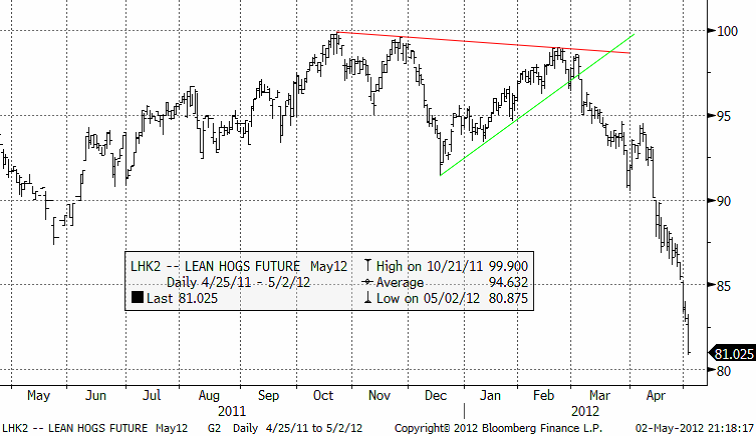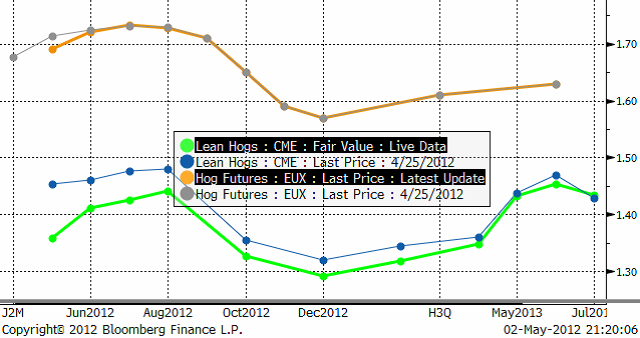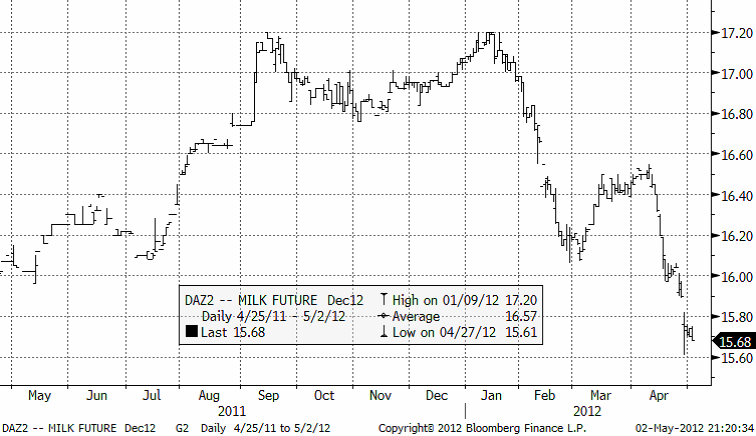Analys
SEB – Jordbruksprodukter, vecka 18 2012
 Sådden av majs går framåt mycket fort i USA. Nu är mer än hälften sått. Höstvetet är i mycket gott skick och det brukar leda till en stor skörd. På torsdag nästa vecka är det dags för WASDE-rapport igen. Den väntas vara ”bullish” sojabönor och ”bearish” vete och majs.
Sådden av majs går framåt mycket fort i USA. Nu är mer än hälften sått. Höstvetet är i mycket gott skick och det brukar leda till en stor skörd. På torsdag nästa vecka är det dags för WASDE-rapport igen. Den väntas vara ”bullish” sojabönor och ”bearish” vete och majs.
International Grains Council (IGC) skriver i sin senaste rapport att de globala marknaderna för spannmål och oljeväxter har påverkats kraftigt av en rad olika bedömningar av grödorna under april, där osäkerheten kring grödornas tillstånd har hjälpt till att upprätthålla en period av hög prisrörlighet.
Mestadels goda utsikter för den kommande amerikanska vete- och majsskörden tyngde marknaderna, medan resultaten var mer osäkra på andra håll och där det ogynnsamma vädrets effekter och dess påverkan på grödor i Europa och OSS fortfarande håller på att identifieras. Sojabönskomplexet har hållit sig fortsatt starkt allteftersom produktionsestimaten i Sydamerika successivt har justerats ned.
 För vete, har nedgången i priserna i USA framförallt triggats av gynnsamma växtförhållanden, men det negativa, ”bearish”, sentimentet har mildrats av nedjusteringar i prognoserna för EU’s produktion samt en stark efterfrågan på gammal skörd, speciellt till foder. Den kraftiga ökningen i majspriserna i slutet på förra månaden har urholkats av en ökad optimism över att nästa skörd i USA kommer att bli mycket stor. Nedjusterade estimat över produktionen av i Sydamerika har gett stöd och drivit sojabönsmarknaden högre, med frontkontraktet på CBOT som nu närmar sig 4-års högsta.
För vete, har nedgången i priserna i USA framförallt triggats av gynnsamma växtförhållanden, men det negativa, ”bearish”, sentimentet har mildrats av nedjusteringar i prognoserna för EU’s produktion samt en stark efterfrågan på gammal skörd, speciellt till foder. Den kraftiga ökningen i majspriserna i slutet på förra månaden har urholkats av en ökad optimism över att nästa skörd i USA kommer att bli mycket stor. Nedjusterade estimat över produktionen av i Sydamerika har gett stöd och drivit sojabönsmarknaden högre, med frontkontraktet på CBOT som nu närmar sig 4-års högsta.
Arealen för spannmål under 2012/13 förväntas öka med 1.6% till 539 miljoner hektar, den högsta på 16 år. Den totala vetearealen kommer sannolikt inte att förändras så mycket jämfört med 2011/12, medan arealen för majs och korn kommer att öka, framförallt i Nordamerika och OSS. Baserat på de senaste siffrorna över sådd areal och med hänsyn till visst bortfall av höstvete, justeras prognosen ned för spannmålsproduktionen under 2012/13 med 7 mt till 1 869 mt, vilket dock är en ökning med 1.5% sedan förra året. Veteproduktionen förväntas minska medan produktionen av majs, korn, durra, havre och råg förväntas öka. Den globala konsumtionen av spannmål beräknas öka med 1.5% jämfört med förra året, till rekordhöga 1865 mt, där användning av spannmål som foder beräknas stiga jämförelsevis snabbare än användningen till livsmedel eller till industriell bearbetning. En stigande efterfrågan på kött i utvecklingsländer förväntas vara en bidragande orsak till ökad användning av foder, men det kan däremot komma att bli ett litet skifte från vete till majs. Den globala efterfrågan på industriprodukter, såsom stärkelse, förväntas öka, medan efterfrågan från den amerikanska etanolsektorn kan komma att minska. Utgående lager i slutet på 2012/13 förväntas stiga något till 383 mt, en ökning för andra året i rad, och hos de största exportörerna förväntas den uppgå till 139 mt, främst pga högre amerikanska majslager.
Den globala handeln förväntas öka med 1% till 263 mt, till följd av ökad efterfrågan på kvarnvete och foder. Men en del av foderefterfrågan beräknas skifta tillbaka till majs, och handeln med den grödan förväntas stiga för fjärde året i rad – inklusive en ökad import till Kina – och en ökad konkurrens från majs förväntas begränsa den globala handeln med fodervete. Efter en stark ökning under 2011/12, förväntas inga större förändringar i handeln med korn.
Vi ser i ovanstående tabell, att IGC justerar upp utgående lager. Sammantaget är rapporten alltså ”bearish”.
CME förlänger öppettiderna för spannmåls- och oljeväxt-terminer och optioner. Nuvarande öppettider är från 18:00 – 07:15 och från 9:30 till 13:15 från söndag till måndag, Chicagotid. Från den 14 maj blir öppettiden på söndag till måndag från 17:00 till 16:00 och under måndag till fredag från 18:00 till 16:00. Det är alltså stängt bara två timmar varje dygn. Detta betyder också att det kommer att vara öppet för handel på CBOT när WASDE-rapporterna kommer. Tidigare var det bara Matif som var öppet.
Odlingsväder
UK Met Office förutspådde för drygt en månad sedan en onormalt torr aprilmånad, med allvarliga konsekvenser “…drought impacts in the coming months are virtually inevitable.” Sedan visade det sig att april blev den blötaste aprilmånaden på 100 år. Met Office har gjort sig känt för sina simuleringsmodeller körda genom en superdator som förbrukar lika mycket elektricitet som 1000 normala villor. Även solen har fläckar, som en del ”skeptiker” kanske skulle ha sagt. Så över till andra sidan jorden, till Australiens Met Office: ENSO-förhållandena är fortsatt normala. Southern Oscillation Index (SOI) har hållit sig mellan -7 och -8 den senaste veckan. SOI-värden mellan -8 och +8 indikerar neutrala ENSO-förhållanden.
ENSO går det faktiskt att göra tillförlitliga prognoser på, som sträcker sig upp till sex månader framåt i tiden. Dessa pekar, som vi tidigare sett, på neutrala förhållanden (bra) eller El Niño (bra). I Sydamerika förbereder man sig på att kunna inleda vårbruket om några månader under fuktiga och ideala förhållanden för att skapa en rekordskörd.
Vete
Matifvetet med novemberleverans har som stigit från 170 euro per ton i november till 201.75 euro nu, har tappat momentum i sprisuppgången. Stödet för uppåttrenden ligger nu strax under. Antingen bryts stödet eller så måste uppgången fortsätta. Med så mycket positiva nyheter om väder, stor areal för majs och crop conditions, vore det konstigt om priset fick för sig att stiga ytterligare.
Nedan ser vi Chicagovetet med leverans i december. Vi skrev för en vecka sedan att det tycks finnas ett tekniskt stöd på 650 cent. Att det nu hållit, kan möjligtvis tolkas som en något ”bullish” indikation.
Nedan ser vi hur terminspriserna på Matif och Chicago förändrats den senaste veckan. Det har varit obetydliga förändringar den senaste veckan. Contangot har ökat i Chicagovetet, men på Matif är det nästan ingen förändring alls.
Crop condition för höstvetet i USA, som rapporterades i måndags kväll klockan 22, ligger på 64% good / excellent. Ratings över 60% har (nästan) alltid lett fram till stora skördar.
IGC:s prognos för den globala vete produktionen under 2012/13 justeras ned med 5 mt till 676 mt, ungefär 19 mt lägre än förra årets estimerade rekordproduktion. Prognosen för EU sänks kraftigt på grund av rapporter om värre skador än väntat på Europas grödor som en följd av det kalla vädret i februari och den senaste tidens torka, som samtidigt som den lindras på kontinentens västra delar ökar som ett växande hot för grödorna i öster. Lägre skördar innebär också att prognosen för globala lager i slutet på 2012/13 justeras ned med 2 mt till 206 mt från den historiskt höga nivån 210 mt som förväntas uppnås i slutet på denna säsong.
Tillväxten inom livsmedel, industriell användning och ökat antal vete-baserade etanol anläggningar förväntas uppvägas av en minskad foderanvändning, men den totala globala konsumtionen förväntas endast visa en begränsad nedgång. Efter att ha nått en ny topp om 140 mt under föregående år, kan en minskad import till foder användning komma att minska den globala handeln med vete med ca 5 mt, men mycket kommer att bero på prisnivån för fodervete i förhållande till majs.
Den senaste prognos för 2012 års veteproduktion i OSS Europa från FAO ligger på 73.7 mt, en nedgång med ca 10 procent från förra årets rekordskörd och under genomsnittet för de senaste fem åren. Detta beror främst på dåliga utsikter för Ukraina, där en skarp nedgång i produktionen av vete väntas reflektera ogynnsamma förhållanden denna säsong: vissa större spannmålsproducerande delar av landet har drabbats hårt av torka sedan sådden förra hösten, samtidigt som utvintring har varit högre än normalt på grund av den stränga kylan i kombination med begränsat snötäcke. De värst drabbade områdena förväntas ersättas med andra grödor under våren. Med en kraftigt förväntad minskning av skördad areal och lägre avkastning förväntas produktionen av vete i Ukraina att uppgå till 14 mt, nästan 40 procent under förra årets rekordskörd och väl under genomsnittet de senaste fem åren.
I Ryssland däremot, pekar de senaste indikationerna på en marginell ökning av produktionen av vete under 2012 till följd av ökad sådd areal som ett svar på fortsatt höga priser. De flesta grödorna i Ryssland skyddades också av ett fullgott snötäcke under vintern. Den utvintring som drabbat vissa grödor förväntas vara genomsnittlig, trots perioder av sträng kyla. Utifrån ett antagande om normala förhållanden under resten av växtsäsongen förväntas produktionen uppgå till 56.8 mt, en ökning med ca 1 procent från förra årets skörd.
I Vitryssland är utsikterna också gynnsamma för årets veteproduktion, där vetet står för en fjärdedel av landets årliga spannmålsproduktion.
I Moldavien är utsikterna för höstvete och korn fortfarande osäkra på grund av torka i vissa delar av landet under hösten och sträng kyla under vintern. Sådden av majs förväntas öka under våren för att kompensera bortfallet av vete.
I Ryssland och Ukraina har exportpriserna på kvarnvete stigit med 13 procent under de senaste 4 månaderna, främst på grund av oro för det torra vädrets påverkan på 2012 års vete grödor i Ukraina. På dessa nuvarande nivåer är priserna fortfarande höga, trots ett fall under förra årets andra halva i samband med 2011 års skörd, och påverkar inhemska priser i importländer inom OSS regionen, i synnerhet Kaukasus-länderna som är starkt beroende av import av spannmål från Ryssland och Ukraina.
I OSS Asien är vete den huvudsakliga grödan. Kazakstan är den största producenten och merparten av grödan sås i april och maj. Sådden pågår nu för fullt i de södra regionerna och i mitten av april var 29 procent avklarad. Sådd areal beräknas officiellt till 13 500 hektar, en liten minskning mot föregående års nivå. Den siffran kan dock komma att minska ytterligare på grund av dålig jordfuktighet efter det torra vädret under hösten och otillräcklig med snö under vintern, framförallt i landets viktiga spannmålsproducerande centrala delar och vissa delar i norr, särskilt oblasterna Akmola, Karaganda och Pavlodar. Det slutliga utfallet kommer dock att bero på regn under de kommande månaderna. Minskad sådd i kombination med en återgång till en mer genomsnittlig avkastning efter förra årets höga nivåer, kommer sannolikt att resultera i en betydligt lägre produktion den här säsongen.
På andra håll i regionen visar tidiga prognoser att, trots en lång vinter, att spannmålsproduktionen kommer att öka från förra årets nivåer i nästan alla länder och särskilt i Armenien där spannmålsproduktionen beräknas bli 13 procent högre. Sammantaget så har spannmålsproduktionen under de senaste åren i Kaukasus länderna (Azerbajdzjan, Armenien och Georgien) fått politiskt stöd och gynnats av relativt goda väderförhållanden men trots detta är länderna starkt beroende av import av spannmål, främst vete.
ADAS rapporterar att Storbritanniens vetegrödor överlag är i ”mycket bra skick”, tack vare regnet under april. Svalare temperaturer fick grödornas tillväxt att avta något under samma månad och utvecklingen är nu ”normal” för denna tid på året jämfört med slutet av mars när grödorna låg långt före.
Maltkorn
Novemberkontraktet på maltkorn har fortsatt att inte röra sig mycket. Priset håller sig över 220 euro, en nivå som köpare tidigare tyckt varit ”för billigt”.
Tillståndet för Storbritanniens höstkorn är mycket bra enligt ADAS och sådden av vårkorn är klart till 96% och ser lovande ut. Nedan ser vi utvecklingen / takten i sådden av vårkorn i Storbritannen. Grön stapel är 2012. Som vi ser såddes det mesta i mars. Det fick sedan en ordentlig rotblöta och lite kallare väder i april.
Potatis
Potatispriset för leverans nästa år, steg oväntat idag. Den senaste veckan har priset stigit från 14 euro per deciton till 14.70 euro.
Majs
Priset på decembermajs har inte haft någon vidare fart nedåt efter andra besöket uppe på 550 cent. Vi noterar också stigande bottnar, som bildar ett stöd. Igår (onsdag) föll priset stadigt ner mot det här stödet. Det drar ihop sig till ett test av det de närmaste dagarna.
Den 27 april var sådden till 53% klar, vilket är en ökning från 28% för en vecka sedan.
Nedan ser vi hur långt sådden nått per i måndags i olika delstater i USA:
IGC skriver i sin nya rapport att en ökad sådd under 2012 förväntas bidra till att global majsproduktion ökar med 4% till 900 mt. Viktigaste faktorn bakom detta är större skördar i USA och Ukraina, den största producenten utanför USA.
Räknar man in de globala (små) majslagren som förväntas uppgå till 129 mt i slutet på innevarande säsong kan det globala utbudet komma att toppa 1 miljard ton för första gången någonsin, med tillhörande goda exportmöjligheter.
Även med en ökad foderanvändning kommer produktionen att vara tillräcklig för att utöka lagren till 3-års högsta på 135 mt, vilket inkluderar en återhämtning i USA. Ingen större förändring förväntas inom industriell användning på grund av minskad efterfrågan i den amerikanska etanolsektorn. Den globala handeln förväntas öka med 6%.
Sojabönor
Marknaden testade mycket riktigt 1400 cent igen i veckan som gick. Men därefter föll priserna tillbaka under onsdagen (igår). Priset ligger nu precis på stödlinjen. Om den bryts på nedsidan signaleras att den stigande trenden från botten i december är över. Detta återstår att se bekräftas.
Sådden går fort framåt i USA. Den 20 april var 12% sått i USA. Förra veckan var det 6%. Vi ser noteringarna i diagrammet nedan som med blå kvadrater. Hittills ser det tidigt och bra ut.
Till följd av ytterligare nedjusteringar i Sydamerika, estimerar IGC den globala produktionen av sojabönor för 2011/12 till 238.4 mt, en minskning med 11% från föregående års rekord. Efter en dramatisk tillväxt under tidigare år, förväntas den globala handeln med sojabönor att minska för andra året i rad, om än marginellt, eftersom ökad export till Asien – framförallt Kina – uppvägs av minskad import från andra länder, inklusive EU. Den globala handeln med sojamjöl förväntas öka med ungefär 1% till en historisk högsta nivå om 57.6 mt. Buenos Aires Grain Exchange har återigen sett över sin prognos för Argentinas produktion av sojabönor. De justerar ned den till 43 mt från förra veckans 44 mt, då torkan tidigare under säsongen har skadat grödorna och därmed minskat avkastningen. Nedan ser vi en tabell med de olika prognosmakarnas prognoser för skördarna i Argentina. USDA ligger nu högt, som vi nämnde förra veckan, och väntas justera ner Sydamerikas skörd, i WASDE-rapporten nästa vecka.
Raps
Priset på novemberterminen har stabiliserat sig strax under 480 euro per ton. Flera försök har gjorts att pressa priset över 480 euro, men säljare har kommit in varje gång.
Rapsproduktionen i EU är på väg att falla till ett 6-års lägsta på 17.6 mt under 2012 efter att de svåra väderförhållandena under vintern har skadat grödorna, och på så sätt ökat farhågorna för ett begränsat utbud samt gett priserna på oljeväxten en rejäl skjuts uppåt, enligt StrategieGrains. Den stränga kylan har skadat grödorna i flera EU-länder. Torkan i år samt svängningar i temperaturen under april kan ge upphov till ytterligare problem.
Den genomsnittliga avkastningen för årets skörd beräknas uppgå till 2.95 ton per hektar (2.85 ton 2011), men arealen förväntas falla till ett 6-års lägsta på 6 miljoner hektar, en minskning från 6.8 miljoner hektar förra året. OilWorld justerar också ned sin prognos ytterligare för EU’s raps produktion under 2012 till 18.21 mt mot den tidigare uppskattningen på 18.48 mt och jämfört med 19.1 mt under 2011. Imorgon torsdag lanserar Matif ytterligare en kontraktsmånad, november 2014, på raps. Både futures och optioner noteras.
Gris
Majkontraktet fick inte någon rekyl uppåt, utan fallet utlöste rena panikförsäljningen. Priset har nu på bara två månader fallit från nära 100 cent till 81 cent.
Nedan ser vi terminspriserna på Eurex i euro per kilo och på CME omräknat till euro per kilo. Vi ser att priserna ligger mycket lägre i USA. Det är framförallt de korta terminskontrakten i USA som fallit. En liten effekt av det amerikanska prisfallet har som vi ser flyttat över till Tyskland och påverkat majkontraktet på Eurex. Ytterligare prisfall i Europa ”borde” följa.
Mjölk
Mjölkpriset föll som för en vecka sedan hade fallit under 16 cent, fortsatte fallet i veckan och har nu temporärt i alla fall, stabiliserats på 15.50 ungefär. Senast betalt för decemberleverans är 15.68 cent per pund. Hittills i år har priset fallit från 17:20 cent till 15.68 cent.
För några dagar sedan var det en artikel i ATL om ”det höga mjölkpriset”. Det verkar som om dagspressen skriver om saker som hände i marknaden för flera månader sedan. Om några månader kanske vi får läsa en artikel om hur det låga mjölkpriset slagit. Vill man hänga med när det händer och innan andra fattar det, bör man kanske hellre läsa det här veckobrevet.
[box]SEB Veckobrev Veckans råvarukommentar är producerat av SEB Merchant Banking och publiceras i samarbete och med tillstånd på Råvarumarknaden.se[/box]
Disclaimer
The information in this document has been compiled by SEB Merchant Banking, a division within Skandinaviska Enskilda Banken AB (publ) (“SEB”).
Opinions contained in this report represent the bank’s present opinion only and are subject to change without notice. All information contained in this report has been compiled in good faith from sources believed to be reliable. However, no representation or warranty, expressed or implied, is made with respect to the completeness or accuracy of its contents and the information is not to be relied upon as authoritative. Anyone considering taking actions based upon the content of this document is urged to base his or her investment decisions upon such investigations as he or she deems necessary. This document is being provided as information only, and no specific actions are being solicited as a result of it; to the extent permitted by law, no liability whatsoever is accepted for any direct or consequential loss arising from use of this document or its contents.
About SEB
SEB is a public company incorporated in Stockholm, Sweden, with limited liability. It is a participant at major Nordic and other European Regulated Markets and Multilateral Trading Facilities (as well as some non-European equivalent markets) for trading in financial instruments, such as markets operated by NASDAQ OMX, NYSE Euronext, London Stock Exchange, Deutsche Börse, Swiss Exchanges, Turquoise and Chi-X. SEB is authorized and regulated by Finansinspektionen in Sweden; it is authorized and subject to limited regulation by the Financial Services Authority for the conduct of designated investment business in the UK, and is subject to the provisions of relevant regulators in all other jurisdictions where SEB conducts operations. SEB Merchant Banking. All rights reserved.
Analys
Brent crude set to dip its feet into the high $50ies/b this week

Parts of the Brent crude curve dipping into the high $50ies/b. Brent crude fell 2.3% over the week to Friday. It closed the week at $61.29/b, a slight gain on the day, but also traded to a low of $60.14/b that same day and just barely avoided trading into the $50ies/b. This morning it is risk-on in equities which seems to help industrial metals a little higher. But no such luck for oil. It is down 0.8% at $60.8/b. This week looks set for Brent crude to dip its feet in the $50ies/b. The Brent 3mth contract actually traded into the high $50ies/b on Friday.

The front-end backwardation has been on a weakening foot and is now about to fully disappear. The lowest point of the crude oil curve has also moved steadily lower and lower and its discount to the 5yr contract is now $6.8/b. A solid contango. The Brent 3mth contract did actually dip into the $50ies/b intraday on Friday when it traded to a low point of $59.93/b.
More weakness to come as lots of oil at sea comes to ports. Mid-East OPEC countries have boosted exports along with lower post summer consumption and higher production. The result is highly visibly in oil at sea which increased by 17 mb to 1,311 mb over the week to Sunday. Up 185 mb since mid-August. On its way to discharge at a port somewhere over the coming month or two.
Don’t forget that the oil market path ahead is all down to OPEC+. Remember that what is playing out in the oil market now is all by design by OPEC+. The group has decided that the unwind of the voluntary cuts is what it wants to do. In a combination of meeting demand from consumers as well as taking back market share. But we need to remember that how this plays out going forward is all at the mercy of what OPEC+ decides to do. It will halt the unwinding at some point. It will revert to cuts instead of unwind at some point.
A few months with Brent at $55/b and 40-50 US shale oil rigs kicked out may be what is needed. We think OPEC+ needs to see the exit of another 40-50 drilling rigs in the US shale oil patches to set US shale oil production on a path to of a 1 mb/d year on year decline Dec-25 to Dec-26. We are not there yet. But a 2-3 months period with Brent crude averaging $55/b would probably do it.
Oil on water increased 17 mb over the week to Sunday while oil in transit increased by 23 mb. So less oil was standing still. More was moving.

Crude oil floating storage (stationary more than 7 days). Down 11 mb over week to Sunday

The lowest point of the Brent crude oil curve versus the 5yr contract. Weakest so far this year.

Crude oil 1mth to 3mth time-spreads. Dubai held out strongly through summer, but then that center of strength fell apart in late September and has been leading weakness in crude curves lower since then.

Analys
Crude oil soon coming to a port near you

Rebounding along with most markets. But concerns over solidity of Gaza peace may also contribute. Brent crude fell 0.8% yesterday to $61.91/b and its lowest close since May this year. This morning it is bouncing up 0.9% to $62.5/b along with a softer USD amid positive sentiment with both equities and industrial metals moving higher. Concerns that the peace in Gaza may be less solid than what one might hope for also yields some support to Brent. Bets on tech stocks are rebounding, defying fears of trade war. Money moving back into markets. Gold continues upwards its strong trend and a softer dollar helps it higher today as well.

US crude & products probably rose 5.6 mb last week (API) versus a normal seasonal decline of 2.4 mb. The US API last night partial and thus indicative data for US oil inventories. Their data indicates that US crude stocks rose 7.4 mb last week, gasoline stocks rose 3.0 mb while Distillate stocks fell 4.8 mb. Altogether an increase in commercial crude and product stocks of 5.6 mb. Commercial US crude and product stocks normally decline by 2.4 mb this time of year. So seasonally adjusted the US inventories rose 8 mb last week according to the indicative numbers by the API. That is a lot. Also, the counter seasonal trend of rising stocks versus normally declining stocks this time of year looks on a solid pace of continuation. If the API is correct then total US crude and product stocks would stand 41 mb higher than one year ago and 6 mb higher than the 2015-19 average. And if we combine this with our knowledge of a sharp increase in production and exports by OPEC(+) and a large increase in oil at sea, then the current trend in US oil inventories looks set to continue. So higher stocks and lower crude oil prices until OPEC(+) switch to cuts. Actual US oil inventory data today at 18:00 CET.
US commercial crude and product stocks rising to 1293 mb in week 41 if last nights indicative numbers from API are correct.

Crude oil soon coming to a port near you. OPEC has lifted production sharply higher this autumn. At the same time demand for oil in the Middle-East has fallen as we have moved out of summer heat and crude oil burn for power for air-conditioning. The Middle-East oil producers have thus been able to lift exports higher on both accounts. Crude oil and condensates on water has shot up by 177 mb since mid-August. This oil is now on its way to ports around the world. And when they arrive, it will likely help to lift stocks onshore higher. That is probably when we will lose the last bit of front-end backwardation the the crude oil curves. That will help to drive the front-month Brent crude oil price down to the $60/b line and revisit the high $50ies/b. Then the eyes will be all back on OPEC+ when they meet in early November and then again in early December.
Crude oil and condensates at sea have moved straight up by 177 mb since mid-August as OPEC(+) has produced more, consumed less and exported more.

Analys
The Mid-East anchor dragging crude oil lower

When it starts to move lower it moves rather quickly. Gaza, China, IEA. Brent crude is down 2.1% today to $62/b after having traded as high as $66.58/b last Thursday and above $70/b in late September. The sell-off follows the truce/peace in Gaze, a flareup in US-China trade and yet another bearish oil outlook from the IEA.

A lasting peace in Gaze could drive crude oil at sea to onshore stocks. A lasting peace in Gaza would probably calm down the Houthis and thus allow more normal shipments of crude oil to sail through the Suez Canal, the Red Sea and out through the Bab-el-Mandeb Strait. Crude oil at sea has risen from 48 mb in April to now 91 mb versus a pre-Covid normal of about 50-60 mb. The rise to 91 mb is probably the result of crude sailing around Africa to be shot to pieces by the Houthis. If sailings were to normalize through the Suez Canal, then it could free up some 40 mb in transit at sea moving onshore into stocks.
The US-China trade conflict is of course bearish for demand if it continues.
Bearish IEA yet again. Getting closer to 2026. Credibility rises. We expect OPEC to cut end of 2025. The bearish monthly report from the IEA is what it is, but the closer we get to 2026, the more likely the IEA is of being ball-park right in its outlook. In its monthly report today the IEA estimates that the need for crude oil from OPEC in 2026 will be 25.4 mb/d versus production by the group in September of 29.1 mb/d. The group thus needs to do some serious cutting at the end of 2025 if it wants to keep the market balanced and avoid inventories from skyrocketing. Given that IEA is correct that is. We do however expect OPEC to implement cuts to avoid a large increase in inventories in Q1-26. The group will probably revert to cuts either at its early December meeting when they discuss production for January or in early January when they discuss production for February. The oil price will likely head yet lower until the group reverts to cuts.
Dubai: The Mid-East anchor dragging crude oil lower. Surplus emerging in Mid-East pricing. Crude oil prices held surprisingly strong all through the summer. A sign and a key source of that strength came from the strength in the front-end backwardation of the Dubai crude oil curve. It held out strong from mid-June and all until late September with an average 1-3mth time-spread premium of $1.8/b from mid-June to end of September. The 1-3mth time-spreads for Brent and WTI however were in steady deterioration from late June while their flat prices probably were held up by the strength coming from the Persian Gulf. Then in late September the strength in the Dubai curve suddenly collapsed. Since the start of October it has been weaker than both the Brent and the WTI curves. The Dubai 1-3mth time-spread now only stands at $0.25/b. The Middle East is now exporting more as it is producing more and also consuming less following elevated summer crude burn for power (Aircon) etc.
The only bear-element missing is a sudden and solid rise in OECD stocks. The only thing that is missing for the bear-case everyone have been waiting for is a solid, visible rise in OECD stocks in general and US oil stocks specifically. So watch out for US API indications tomorrow and official US oil inventories on Thursday.
No sign of any kind of fire-sale of oil from Saudi Arabia yet. To what we can see, Saudi Arabia is not at all struggling to sell its oil. It only lowered its Official Selling Prices (OSPs) to Asia marginally for November. A surplus market + Saudi determination to sell its oil to the market would normally lead to a sharp lowering of Saudi OSPs to Asia. Not yet at least and not for November.
The 5yr contract close to fixed at $68/b. Of importance with respect to how far down oil can/will go. When the oil market moves into a surplus then the spot price starts to trade in a large discount to the 5yr contract. Typically $10-15/b below the 5yr contract on average in bear-years (2009, 2015, 2016, 2020). But the 5yr contract is usually pulled lower as well thus making this approach a moving target. But the 5yr contract price has now been rock solidly been pegged to $68/b since 2022. And in the 2022 bull-year (Brent spot average $99/b), the 5yr contract only went to $72/b on average. If we assume that the same goes for the downside and that 2026 is a bear-year then the 5yr goes to $64/b while the spot is trading at a $10-15/b discount to that. That would imply an average spot price next year of $49-54/b. But that is if OPEC doesn’t revert to cuts and instead keeps production flowing. We think OPEC(+) will trim/cut production as needed into 2026 to prevent a huge build-up in global oil stocks and a crash in prices. But for now we are still heading lower. Into the $50ies/b.
-

 Nyheter4 veckor sedan
Nyheter4 veckor sedanOPEC+ missar produktionsmål, stöder oljepriserna
-

 Nyheter2 veckor sedan
Nyheter2 veckor sedanGoldman Sachs höjer prognosen för guld, tror priset når 4900 USD
-

 Nyheter4 veckor sedan
Nyheter4 veckor sedanEtt samtal om guld, olja, fjärrvärme och förnybar energi
-

 Nyheter3 veckor sedan
Nyheter3 veckor sedanBlykalla och amerikanska Oklo inleder ett samarbete
-

 Nyheter3 veckor sedan
Nyheter3 veckor sedanGuld nära 4000 USD och silver 50 USD, därför kan de fortsätta stiga
-

 Analys4 veckor sedan
Analys4 veckor sedanAre Ukraine’s attacks on Russian energy infrastructure working?
-

 Nyheter4 veckor sedan
Nyheter4 veckor sedanGuldpriset uppe på nya höjder, nu 3750 USD
-

 Nyheter3 veckor sedan
Nyheter3 veckor sedanEtt samtal om guld, olja, koppar och stål


